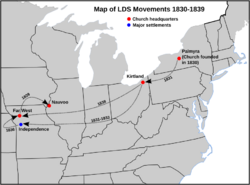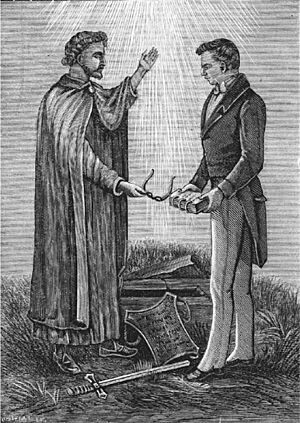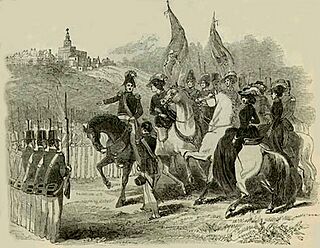History of the Latter Day Saint movement facts for kids
The Latter Day Saint movement is a group of Christian religions. It started in the early 1800s in the United States. This movement led to many different churches, often called Mormonism. Throughout its history, the movement faced many challenges and disagreements. This article will give you an overview of the different groups and beliefs that began with Joseph Smith.
Joseph Smith founded the Latter Day Saint movement. He grew up in New York. Smith said that when he prayed, he saw God the Father and Jesus Christ. He also said he saw angels. This led him to believe that some Christian teachings had been lost. He felt it was his job to bring them back. Other early leaders like Oliver Cowdery, Sidney Rigdon, and Brigham Young also helped shape the movement. A main belief of the Mormon faith is that God still speaks to people today.
How the Movement Began
Religious Excitement in the 1800s
The Latter Day Saint movement started in New York. This was a time of great religious excitement in the early 1800s. This period is known as the Second Great Awakening. Many people were looking for new ways to understand faith. Joseph Smith's family was part of this religious searching. His father and grandfathers also had spiritual experiences.
People in New York at that time also believed in folk religion. This included using special objects like seer stones. Joseph Smith used seer stones after he said he had his First Vision. People used these stones to find things or even to talk with spirits. Many thought this was a normal and good practice back then.
Another important idea was the Restoration Movement. Leaders like Barton W. Stone and Alexander Campbell believed that Christianity had gone off track. They thought the original teachings of Jesus had been lost. They wanted to "restore" the church to how it was in the New Testament. They believed there should be only one Christian church.
Joseph Smith's family lived in this area, which was called the "Burned-Over District". This name came from the many religious revivals happening there. Because there weren't many traditional church leaders, people were open to new religious ideas. This environment helped Joseph Smith become interested in religion.
Masonic Connections
Joseph Smith and some other early church leaders were also Freemasons. They started a Masonic lodge in Nauvoo, Illinois in 1842. There are some similarities between Mormon temple ceremonies and Masonic traditions. Today, The Church of Jesus Christ of Latter-day Saints (LDS Church) does not have a rule about whether Masonry fits with its beliefs.
Joseph Smith's Leadership
Joseph Smith's First Vision
Most Latter Day Saints believe the movement began with Joseph Smith's First Vision. He said this happened around 1820 in the woods near his home. In early stories, he saw Jesus and was told his sins were forgiven. Later, more detailed stories said he saw both God the Father and Jesus. He was also told that all Christian churches at the time were not teaching the full truth.
Angels, Golden Plates, and the Book of Mormon
Smith also spoke of many other visits from angels. One of the first angels he saw was named Moroni. Smith said Moroni appeared to him many times. Moroni showed him where to find Golden Plates buried in a stone box. These plates had ancient writings on them.
According to Smith, the writings told the story of ancient people in America. It said that Jesus visited them. But over time, these people lost their faith. Smith said he translated these writings with God's help. He used the Urim and Thummim or a seer stone. The translated book was published in 1830 as the Book of Mormon.
The Book of Mormon became a very important scripture for Mormons. It was as important as the Bible. The book aimed to teach people about Jesus Christ. It also talked about how pride can lead to problems. It warned about "secret groups" that do bad things. The most important part for Latter Day Saints is when Jesus visits the ancient Americans. He teaches them about his death and resurrection.
Priesthood Authority Restored
Joseph Smith and Oliver Cowdery worked together to translate the Book of Mormon. They felt they needed God's authority to act in His name. This authority is called the Priesthood. They believed it had been lost from the earth.
In 1829, Smith and Cowdery said an angel visited them. This angel was John the Baptist. He gave them the "Holy Priesthood," which included the power to baptize. Later, Smith and Cowdery said they were also visited by Peter, James, and John. These apostles gave them more priesthood authority. This authority allowed them to lead the church.
The Church of Christ Begins

After receiving the Priesthood, Joseph Smith and Oliver Cowdery began baptizing people. These early followers called themselves "the Church of Christ." They lived in different towns in New York.
In April 1830, Joseph Smith and about 50 believers formally organized the Church of Christ. This meeting was very spiritual. People had visions and spoke in different languages. The church also chose its first leaders. Smith and Cowdery were chosen as "apostles of Jesus Christ."
Moving to Ohio
The church grew quickly when Sidney Rigdon joined. He was a former minister who brought hundreds of his followers into the movement. Rigdon became an important leader. By 1831, the church's main gathering place was in Kirtland, Ohio. Smith encouraged members to move there.
In Kirtland, the church changed its name to the "Church of the Latter Day Saints." New beliefs and leadership roles were added. The church tried to create a shared economy called the "Law of Consecration." This meant people would share their property. The idea of the priesthood was also developed further. New leadership positions like the First Presidency and the Quorum of the Twelve were created.
Many spiritual experiences happened in Kirtland. People reported seeing angels and receiving messages from God. However, some members claimed to receive messages that disagreed with Joseph Smith. Smith taught that only the Prophet could receive new teachings for the whole church. This helped bring order to the church.
The first temple of the movement was built in Kirtland. Many spiritual events were reported when the Kirtland Temple was dedicated. Smith also introduced new teachings, like the "Word of Wisdom," which encourages healthy living. He also acquired Egyptian scrolls. He said these contained writings from ancient prophets.
In 1837, a bank started by Smith and Rigdon failed. This caused about 300 members to leave the church. Some of these people tried to take control of the church in Kirtland. Smith and Rigdon then moved to Missouri. Many loyal members followed them.
Challenges in Missouri
While the church was growing in Kirtland, another gathering place was set up in Jackson County, Missouri. Joseph Smith taught that this area would be the "center place" for the City of Zion. This would be a new Jerusalem. Latter Day Saints began to settle there in 1831.
The rapid growth of the Latter Day Saints worried other residents. They feared losing control of the county. In 1833, non-Mormon groups forced the Mormons out of Jackson County. The Latter Day Saints settled in nearby areas.
Years passed, but the Mormons were not allowed to return to Jackson County. New converts kept moving to Missouri. In 1836, a new county, Caldwell County, was created just for Mormon settlement. The church's main center became Far West.
Church Headquarters in Far West
In 1838, Joseph Smith and Sidney Rigdon moved the church headquarters to Far West. During this time, the church's name was changed to "Church of Jesus Christ of Latter Day Saints." The "Law of Tithing" was also introduced. This meant members would give a portion of their income to the church.
Conflicts with non-Mormon settlers grew. These conflicts led to what is called the 1838 Mormon War. Some church leaders left because of the church's actions. As a result of the war, Smith and other leaders were put in Liberty, Missouri. Most Latter Day Saints were forced to leave the state.
Building Nauvoo, Illinois
In 1839, the Latter Day Saints found a new home in Nauvoo. Smith and other leaders escaped from Missouri and joined them. In 1841, they began building a new temple. This temple was much grander than the one in Kirtland. Nauvoo also had its own courts and a militia called the "Nauvoo Legion." These things gave the Latter Day Saints a lot of independence.
In Nauvoo, Joseph Smith introduced more new practices. These included Baptism for the dead (baptizing on behalf of those who have died) and the Endowment (special temple ceremonies). He also began to teach about a unique family structure to some leaders.
In 1844, a newspaper called the Nauvoo Expositor was started. It planned to reveal some of the church's new practices. Joseph Smith, as mayor, ordered the destruction of the newspaper's printing press.
Joseph Smith's Death
When Latter Day Saints gathered in large numbers, they often faced opposition. Neighbors worried about their growing political power. They also found some Mormon beliefs hard to accept. These included a different view of God and the idea of new scripture beyond the Bible.
Smith's destruction of the Expositor made these fears worse. People in Illinois called for his arrest. Smith went to jail in Carthage. The governor left the jail, taking the only neutral local militia with him. A mob then attacked the jail. Joseph Smith and his brother Hyrum were killed.
The men tried for the murders were later found not guilty.
Changes in Leadership
The Succession Crisis of 1844
After Joseph Smith's death, it was unclear who would lead the church. His brother Hyrum, who would have been his likely successor, died with him. Other potential successors had been removed from the church.
The main people who could lead were:
- Sidney Rigdon, the only remaining member of the church's highest council.
- The High Council in Nauvoo, led by William Marks.
- The Quorum of the Twelve Apostles, led by Brigham Young.
Joseph Smith's wife, Emma, wanted Marks to be president. But Marks thought Rigdon had a stronger claim.
At a church meeting in Nauvoo in August 1844, Rigdon and Young presented their cases. Rigdon argued he should be the church's "guardian." Young argued that without Smith, the Quorum of the Twelve Apostles should lead. The members voted overwhelmingly for Young's idea. Many said Brigham Young briefly looked and sounded like Joseph Smith during his speech. Soon after, Rigdon left Nauvoo and started his own church.
Another person, James J. Strang, also claimed to be Smith's successor. He said Smith had sent him a letter. But Strang was new to the church. He did not have much support in Nauvoo. He did gain followers, but his death in 1856 ended his group.
More Divisions and Moving West
After Rigdon left, Brigham Young and most of the Twelve Apostles took control in Nauvoo. Joseph Smith's last living brother, William, also disagreed with the Twelve. This led to the Smith family leaving the main church. Many of them later joined the Reorganized Church of Jesus Christ of Latter Day Saints. This church formed in the 1860s around Joseph Smith's oldest son, Joseph Smith III.
Meanwhile, conflicts between Mormons and non-Mormons in Nauvoo grew. This led to the "Mormon War in Illinois." Latter Day Saints were forced from their homes and gathered in Nauvoo for safety. By late 1845, it was clear that peace was not possible. Young and the Twelve decided the Latter Day Saints would leave the city. The winter of 1845-46 saw huge preparations for the Mormon Exodus across the Great Plains.
Major Church Splits
The largest group of Latter Day Saints followed nine of the Twelve Apostles west. They stopped in Winter Quarters, Nebraska in 1846. In 1847, they entered the Salt Lake Valley. After setting up this first settlement, Young returned to Winter Quarters. In December 1847, he reorganized his group of the church. He became the head of a new First Presidency. This led to more splits. Young's organization, the LDS Church, is now based in Salt Lake City, Utah.
Most of Sidney Rigdon's church broke apart by 1847. But some followers reorganized as The Church of Jesus Christ in 1862. After James J. Strang's death, most of his followers left his church. But a small group remained loyal. Other leaders also started their own church groups.
Joseph Smith's family stayed in Nauvoo. In 1860, his oldest son, Joseph Smith III, said he received a message to lead a "New Organization." This group brought together many smaller Latter Day Saint groups. It became the Reorganized Church of Jesus Christ of Latter Day Saints, now called the Community of Christ. This is the second largest Latter Day Saint group. Its headquarters are in Independence, Missouri.
Another group, the Church of Christ (Temple Lot), formed in 1863. They were the first Latter Day Saints to return to Independence, Missouri. They wanted to "redeem Zion." They are now based on a part of the original Temple Lot there.
The Latter Day Saint Movement Today
Different Church Groups
The Church of Jesus Christ of Latter-day Saints
This is by far the largest group. It has millions of members. It is still led by Brigham Young's successors. When the Prophet dies, the senior Apostle becomes the new head of the LDS Church. As of 2018, Russell M. Nelson is the church president. The LDS Church is known for its missionary work and helping people worldwide.
Community of Christ
The Community of Christ is the second largest group. It has over 250,000 members. Joseph Smith's descendants led this church until the early 2000s. Today, it is led by President/Prophet Stephen M. Veazey. The Community of Christ is more similar to other Protestant churches in some ways. But they also believe in the Book of Mormon and new scripture. They focus a lot on making peace. Since 1985, they have allowed women to be priesthood leaders. They also dedicated a temple in Independence, Missouri, in 1994.
Smaller Groups
There are many other smaller Latter Day Saint groups. These include the Church of Christ (Temple Lot), which owns the Temple Lot in Independence, Missouri. The Church of Jesus Christ (Cutlerite) was founded by a member of Joseph Smith's council. The Church of Jesus Christ of Latter Day Saints (Strangite) was started by James J. Strang. The Church of Jesus Christ (Bickertonite) was founded by a follower of Sidney Rigdon. Some other groups still practice a unique family structure.
Important Beliefs
Jesus Christ
Latter Day Saints all believe in Jesus Christ. They believe he is the Son of God. They see him as the Savior of the world. They accept his sacrifice as the only way to be saved. This is the main message of their scriptures.
Revelation and Scripture
Latter Day Saints generally believe that God continues to speak to people. They believe the "canon" of scripture is open. This means God can always give new messages to the church. Different groups believe in different revelations. But the idea that God speaks today is central.
Latter Day Saints believe in the Bible and other ancient scriptures. However, they often see the modern prophet as a very important source of God's word. This is because the prophet receives current instructions from God.
Priesthood Authority
Most Latter Day Saint groups believe that authority from Jesus Christ is needed. This authority allows people to baptize, give the gift of the Holy Ghost, or perform the Lord's Supper. They believe this Priesthood authority came from Jesus. It was given to Joseph Smith and Oliver Cowdery by Peter, James, and John.
Zion
Many of Joseph Smith's early messages talked about building Zion. This would be a new Jerusalem. It would be a perfect religious community in Jackson County, Missouri. The Prophet asked his followers to give everything they had for this goal. But when they struggled to live the "Law of Consecration" (sharing all property), Joseph Smith received a message that God would build Zion later. This would happen when the people were ready.
Today, both the Community of Christ and the LDS Church understand Zion as a way of life. It is a community focused on Jesus Christ. But many people still believe that a literal city of Zion will be built in the future.
See also
- Latter Day Saint Historians
- List of articles about Mormonism
- Mormonism and history
- Restorationism (Christian primitivism)



